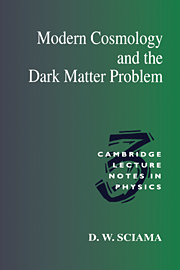Book contents
- Frontmatter
- Contents
- Preface
- Recent Developments
- Part One Dark Matter in Astronomy and Cosmology
- Part Two Ionisation Problems in Astronomy and Cosmology
- Part Three Neutrino Decay and Ionisation in the Universe
- 8 The Radiative Decay of Massive Neutrinos
- 9 Neutrino Decay and the Ionisation of the Milky Way
- 10 Neutrino Decay and the Ionisation of Spiral Galaxies
- 11 The Intergalactic Flux of Ionising Decay Photons
- 12 The Reionisation of the Universe
- Part Four Observational Searches for the Neutrino Decay Line
- References
- Subject index
10 - Neutrino Decay and the Ionisation of Spiral Galaxies
Published online by Cambridge University Press: 11 January 2010
- Frontmatter
- Contents
- Preface
- Recent Developments
- Part One Dark Matter in Astronomy and Cosmology
- Part Two Ionisation Problems in Astronomy and Cosmology
- Part Three Neutrino Decay and Ionisation in the Universe
- 8 The Radiative Decay of Massive Neutrinos
- 9 Neutrino Decay and the Ionisation of the Milky Way
- 10 Neutrino Decay and the Ionisation of Spiral Galaxies
- 11 The Intergalactic Flux of Ionising Decay Photons
- 12 The Reionisation of the Universe
- Part Four Observational Searches for the Neutrino Decay Line
- References
- Subject index
Summary
Introduction
We saw in chapter 6 that some nearby spiral galaxies contain diffuse ionised gas (DIG) reminiscent of the Reynolds layer in our Galaxy. This DIG has been studied in particular detail in NGC 891. It was found difficult to account for the DIG observed in that galaxy several kiloparsecs from its plane in terms of known sources of ionisation. The observers concerned therefore concluded that a new galactic source is required, a conclusion which is reminiscent of the situation prevailing for the Reynolds layer in our Galaxy. In this chapter we examine the hypothesis (Sciama and Salucci 1990) that the new source required is decaying dark matter neutrinos with the same properties as we have already invoked in discussing the Reynolds layer in the previous chapter.
This hypothesis has been criticised by Dettmar and Schulz (1992) on the grounds that the decay photons would not heat the gas to the temperature required to account for the emission line ratios [NII]/ Hα and [SII]/ Hα which they observed. This criticism suffers from the defect that in their calculation they assume that the only heat source for the gas is the decay photons themselves. Since in the decaying neutrino theory Eγ is close to 13.6 eV, it is true that there is not much heat input associated with each ionisation. Indeed this point is relevant to our discussion of the temperature of Lyman α clouds in chapter 11. However, in the present case one would expect that other heating processes should be important.
- Type
- Chapter
- Information
- Modern Cosmology and the Dark Matter Problem , pp. 148 - 160Publisher: Cambridge University PressPrint publication year: 1994



